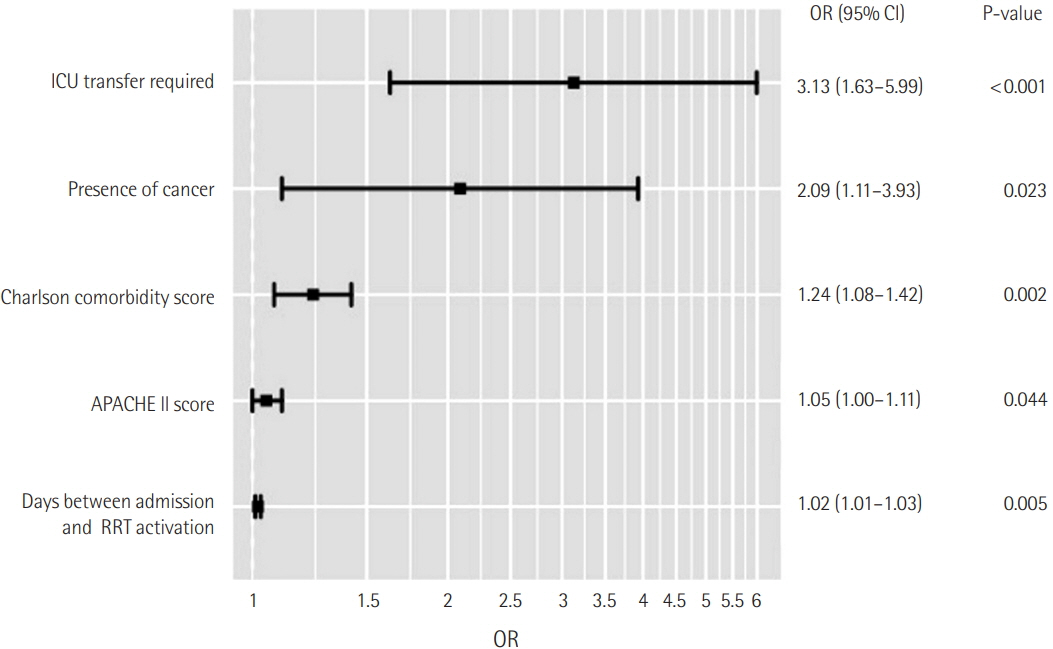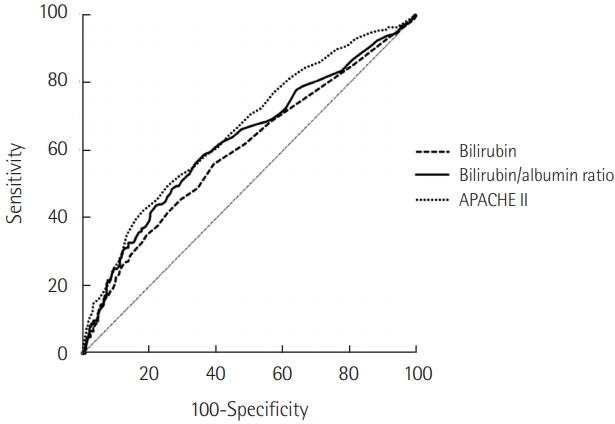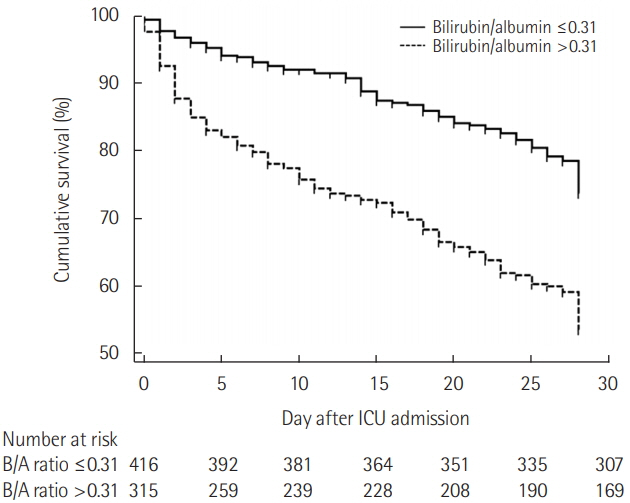Acute Crit Care.
2020 Feb;35(1):24-30. 10.4266/acc.2019.00738.
The role of bilirubin to albumin ratio as a predictor for mortality in critically ill patients without existing liver or biliary tract disease
- Affiliations
-
- 1Division of Pulmonology, Department of Internal Medicine, Severance Hospital, Yonsei University College of Medicine, Seoul, Korea
- KMID: 2500947
- DOI: http://doi.org/10.4266/acc.2019.00738
Abstract
- Background
Hyperbilirubinemia and hypoalbuminemia are frequently appeared and associated with poor prognosis in critically ill patients. We aim to evaluate the association between the bilirubin to albumin ratio and prognosis in intensive care unit (ICU) patients. Methods: This was a retrospective study of 731 patients who were admitted to the medical intensive care unit (MICU) at a tertiary-care center from July 2015 to September 2017. We analyzed the bilirubin to albumin ratio on admission to the MICU, including clinical characteristics and other examinations. Results: The overall 28-day survival of MICU patients was 69.1%. On univariate analysis, Acute Physiology and Chronic Health Evaluation (APACHE) II score (P<0.001), Sequential Organ Failure Assessment score (P<0.001), Simplified Acute Physiology Score II score (P<0.001), Creactive protein (P=0.015), and bilirubin/albumin ratio (P<0.001) were associated with mortality of ICU patients. The receiver operating characteristic curves for ICU patients mortality between bilirubin to albumin ratio and APACHE II score were not statistically significant (P=0.282). On multivariate analysis, higher APACHE II score (hazard ratio [HR], 1.05; 95% CI, 1.03 to 1.06; P<0.001) and bilirubin to albumin ratio (HR, 1.65; 95% CI, 1.23 to 2.20; P=0.001) were independently related to the ICU patient mortality. Conclusions: A higher bilirubin to albumin ratio was related to the unfavorable prognosis and mortality in critically ill patients.
Keyword
Figure
Cited by 1 articles
-
Hepatic dysfunction in critically ill patients
Jeong Hoon Yang
Acute Crit Care. 2020;35(1):44-45. doi: 10.4266/acc.2020.00052.
Reference
-
1. Dhainaut JF, Marin N, Mignon A, Vinsonneau C. Hepatic response to sepsis: interaction between coagulation and inflammatory processes. Crit Care Med. 2001; 29(7 Suppl):S42–7.
Article2. Jenniskens M, Langouche L, Van den Berghe G. Cholestatic alterations in the critically ill: some new light on an old problem. Chest. 2018; 153:733–43.3. Hawker F. Liver dysfunction in critical illness. Anaesth Intensive Care. 1991; 19:165–81.
Article4. Vincent JL, Dubois MJ, Navickis RJ, Wilkes MM. Hypoalbuminemia in acute illness: is there a rationale for intervention? A meta-analysis of cohort studies and controlled trials. Ann Surg. 2003; 237:319–34.5. Brienza N, Dalfino L, Cinnella G, Diele C, Bruno F, Fiore T. Jaundice in critical illness: promoting factors of a concealed reality. Intensive Care Med. 2006; 32:267–74.
Article6. Kramer L, Jordan B, Druml W, Bauer P, Metnitz PG; Austrian Epidemiologic Study on Intensive Care; ASDI Study Group. Incidence and prognosis of early hepatic dysfunction in critically ill patients: a prospective multicenter study. Crit Care Med. 2007; 35:1099–104.7. Pierrakos C, Velissaris D, Felleiter P, Antonelli M, Vanhems P, Sakr Y, et al. Increased mortality in critically ill patients with mild or moderate hyperbilirubinemia. J Crit Care. 2017; 40:31–35.
Article8. Jones AE, Trzeciak S, Kline JA. The Sequential Organ Failure Assessment score for predicting outcome in patients with severe sepsis and evidence of hypoperfusion at the time of emergency department presentation. Crit Care Med. 2009; 37:1649–54.
Article9. Le Gall JR, Lemeshow S, Saulnier F. A new Simplified Acute Physiology Score (SAPS II) based on a European/North American multicenter study. JAMA. 1993; 270:2957–63.
Article10. Artero A, Zaragoza R, Camarena JJ, Sancho S, Gonzalez R, Nogueira JM. Prognostic factors of mortality in patients with community-acquired bloodstream infection with severe sepsis and septic shock. J Crit Care. 2010; 25:276–81.
Article11. Knaus WA, Wagner DP, Draper EA, Zimmerman JE, Bergner M, Bastos PG, et al. The APACHE III prognostic system. Risk prediction of hospital mortality for critically ill hospitalized adults. Chest. 1991; 100:1619–36.12. Ardakani SB, Dana VG, Ziaee V, Ashtiani MT, Djavid GE, Alijani M. Bilirubin/albumin ratio for predicting acute bilirubininduced neurologic dysfunction. Iran J Pediatr. 2011; 21:28–32.13. Hulzebos CV, van Imhoff DE, Bos AF, Ahlfors CE, Verkade HJ, Dijk PH. Usefulness of the bilirubin/albumin ratio for predicting bilirubin-induced neurotoxicity in premature infants. Arch Dis Child Fetal Neonatal Ed. 2008; 93:F384–8.
Article14. Zhang Z. Model building strategy for logistic regression: purposeful selection. Ann Transl Med. 2016; 4:111.
Article15. Zhang Z. Residuals and regression diagnostics: focusing on logistic regression. Ann Transl Med. 2016; 4:195.
Article16. Kortgen A, Paxian M, Werth M, Recknagel P, Rauchfuss F, Lupp A, et al. Prospective assessment of hepatic function and mechanisms of dysfunction in the critically ill. Shock. 2009; 32:358–65.
Article17. Horvatits T, Trauner M, Fuhrmann V. Hypoxic liver injury and cholestasis in critically ill patients. Curr Opin Crit Care. 2013; 19:128–32.
Article18. Fuhrmann V, Kneidinger N, Herkner H, Heinz G, Nikfardjam M, Bojic A, et al. Hypoxic hepatitis: underlying conditions and risk factors for mortality in critically ill patients. Intensive Care Med. 2009; 35:1397–405.
Article19. Fuhrmann V, Kneidinger N, Herkner H, Heinz G, Nikfardjam M, Bojic A, et al. Impact of hypoxic hepatitis on mortality in the intensive care unit. Intensive Care Med. 2011; 37:1302–10.
Article20. Jager B, Drolz A, Michl B, Schellongowski P, Bojic A, Nikfardjam M, et al. Jaundice increases the rate of complications and one-year mortality in patients with hypoxic hepatitis. Hepatology. 2012; 56:2297–304.
Article21. Mesotten D, Wauters J, Van den Berghe G, Wouters PJ, Milants I, Wilmer A. The effect of strict blood glucose control on biliary sludge and cholestasis in critically ill patients. J Clin Endocrinol Metab. 2009; 94:2345–52.
Article22. Vincent JL, Moreno R, Takala J, Willatts S, De Mendonca A, Bruining H, et al. The SOFA (Sepsis-related Organ Failure Assessment) score to describe organ dysfunction/failure. On behalf of the Working Group on Sepsis-Related Problems of the European Society of Intensive Care Medicine. Intensive Care Med. 1996; 22:707–10.23. Le Gall JR, Klar J, Lemeshow S, Saulnier F, Alberti C, Artigas A, et al. The Logistic Organ Dysfunction system. A new way to assess organ dysfunction in the intensive care unit. ICU Scoring Group. JAMA. 1996; 276:802–10.
Article24. Arai T, Yoshikai Y, Kamiya J, Nagino M, Uesaka K, Yuasa N, et al. Bilirubin impairs bactericidal activity of neutrophils through an antioxidant mechanism in vitro. J Surg Res. 2001; 96:107–13.
Article25. Uslu A, Tasli FA, Nart A, Postaci H, Aykas A, Bati H, et al. Human kidney histopathology in acute obstructive jaundice: a prospective study. Eur J Gastroenterol Hepatol. 2010; 22:1458–65.26. Dubois MJ, Bergeron N, Dumont M, Dial S, Skrobik Y. Delirium in an intensive care unit: a study of risk factors. Intensive Care Med. 2001; 27:1297–304.
Article27. Lanone S, Bloc S, Foresti R, Almolki A, Taille C, Callebert J, et al. Bilirubin decreases nos2 expression via inhibition of NAD(P)H oxidase: implications for protection against endotoxic shock in rats. FASEB J. 2005; 19:1890–2.
Article28. Kundur AR, Bulmer AC, Singh I. Unconjugated bilirubin inhibits collagen induced platelet activation. Platelets. 2014; 25:45–50.
Article29. Hulzebos CV, Dijk PH, van Imhoff DE, Bos AF, Lopriore E, Offringa M, et al. The bilirubin albumin ratio in the management of hyperbilirubinemia in preterm infants to improve neurodevelopmental outcome: a randomized controlled trial. BARTrial. PLoS One. 2014; 9:e99466.30. Iskander I, Gamaleldin R, El Houchi S, El Shenawy A, Seoud I, El Gharbawi N, et al. Serum bilirubin and bilirubin/albumin ratio as predictors of bilirubin encephalopathy. Pediatrics. 2014; 134:e1330–9.
Article
- Full Text Links
- Actions
-
Cited
- CITED
-
- Close
- Share
- Similar articles
-
- Important predictor of mortality in patients with end-stage liver disease
- Association of direct bilirubin level with postoperative outcome in critically ill postoperative patients
- APACHE II Score and Multiple Organ Failure Score as Predictors of Mortality Rate of Critically Ill Patients
- Impact of Interhospital Transfer in Mortality of Critically Ill Patients
- Role of Bilirubin in Diabetic Vascular Complications: Can Bilirubin Predict More than Just Liver Disease?




